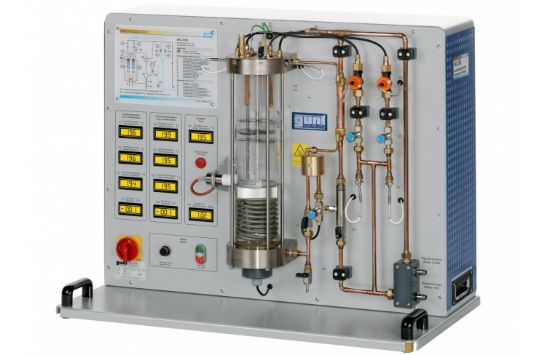GUNT condensation forms when steam meets a medium with a lower temperature than the saturation temperature for the existing partial pressure of the steam. Factors such as the material and surface roughness of the medium influence the heat transfer and thus the type of condensation. In practice, it is usually film condensation. Dropwise condensation only forms when the cooling surface is very smooth and poorly wettable, e.g. Teflon. Knowledge of condensation processes is applied e.g. in steam power plants or at distillation processes.
Product Features
- Demonstrates different condensation processes using two tubular shaped water-cooled condensers made of different materials.
- Dropwise condensation demonstrated with a polished gold-plated condenser surface.
- Film condensation demonstrated on the matt copper surface of the second condenser.
- System tank can be evacuated via a water jet pump.
- Boiling point and pressure varied by controlling cooling and heating power.
- Sensors record temperature, pressure, and flow rate at all relevant points.
- Measured values displayed digitally and can be transmitted directly to a PC via USB.
- Includes data acquisition software.
- Heat transfer coefficient calculated from measured values.
- Allows examination of the influence of non-condensing gases, pressure, and temperature difference between surface and steam in further experiments.
Benefits
- Provides hands-on understanding of film and dropwise condensation.
- Enables analysis of heat transfer mechanisms and influencing factors.
- Comprehensive sensor integration and digital data recording for precise study.
Why Choose the GUNT Condensation Process Experimental Unit?
This unit offers a practical and versatile approach to studying condensation phenomena with clear visual and quantitative analysis, ideal for education and research.

